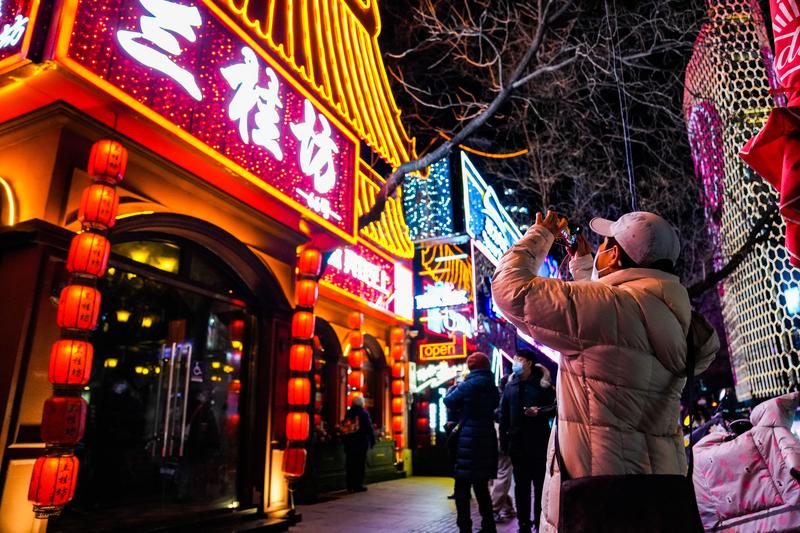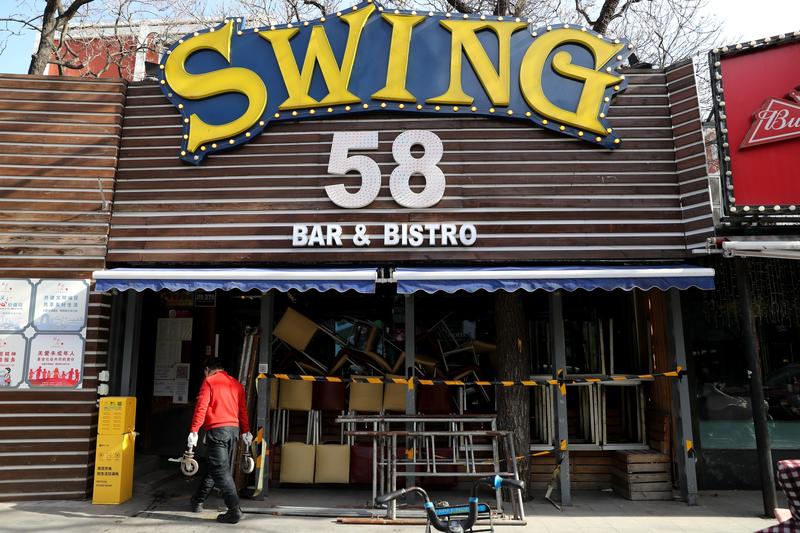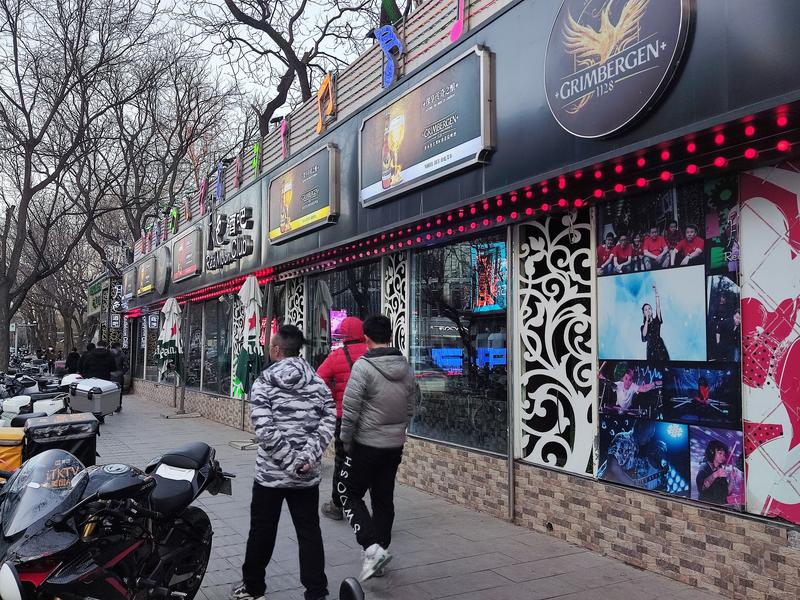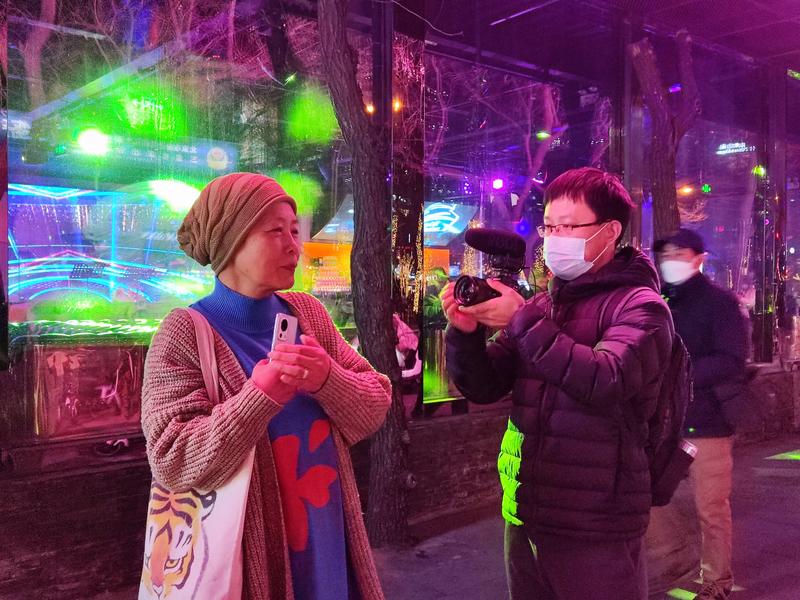Beijing area sets its sights on international consumers
 Visitors flock to bar street in Sanlitun to take pictures on Tuesday night, the last day that the bars were allowed to open. (PHOTO PROVIDED TO CHINA DAILY)
Visitors flock to bar street in Sanlitun to take pictures on Tuesday night, the last day that the bars were allowed to open. (PHOTO PROVIDED TO CHINA DAILY)
In recent decades, bar street in Beijing's Sanlitun area has not only been a place for entertainment, it reflected the past.
As of Wednesday, all bars on the street had been closed. A notice from the authorities dated Dec 25 was posted on their doors, stating that an overhaul of the premises needed to be carried out for safety reasons after a third-party appraisal.
The move marked a new development stage for the time-honored landmark.
Sanlitun gets its name from its three li, or 1.5-kilometer, distance from the Beijing city wall.
In 1952, the Beijing Research Institute of Mechanical and Electrical Technology, the Beijing Dance Academy and Beijing Normal School moved to the area, before many families were relocated to nearby residential communities named Happy Village due to large-scale construction work in the Chinese capital.
As the population grew, Beijing Chao-Yang Hospital and schools such as Beijing No 80 High School, Sanlitun Primary School, Sanlitun No 1 Middle School and Sanlitun No 2 Middle School — the affiliated high school of the Beijing Institute of Fashion Technology — were established in the area.
In the 1960s, Premier Zhou Enlai designated Sanlitun as the second diplomatic zone in Beijing, and many apartments for diplomats were built in the area, making it increasingly prosperous.
 Swing 58, the first bar to appear on the street in 1997, is closed on Tuesday. (WANG ZHUANGFEI / CHINA DAILY)
Swing 58, the first bar to appear on the street in 1997, is closed on Tuesday. (WANG ZHUANGFEI / CHINA DAILY)
Bar street dates to the 1990s. In 1992, when then Chinese leader Deng Xiaoping made his famous South China tour, he said China should focus on economic development and improving people's livelihoods. "It doesn't matter if it's black or white, as long as it catches mice, it's a good cat," he said.
Shortly after the 11th Asian Games were held in Beijing at the Workers' Sports Complex in 1990, a series of auto parts shops opened near Sanlitun, which were known as "auto parts street". The area's influence in the auto industry can be compared to that held today by Zhongguancun, Beijing's high-tech hub.
The first bar, Swing 58, appeared in Sanlitun bar street in 1997, paving the way for many others to follow.
At first, people met to drink and chat in bars such as Swing 58, before discos like Boys and Girls appeared in bar street. Accompanied by strong background music and dazzling lights, these bars often featured singing acts, dancing and other performances.
Due to its proximity to foreign embassies, bar street attracted countless overseas visitors. As bars became more popular, Chinese started to show an interest in them, as they offered a new leisure option after work.
In July 2006, Chinese band Catcher in the Rye released its third album, Our World, at Boys and Girls.
A 60-year-old woman surnamed Dai said she loved to relax in bar street when she was young. "It was fashionable to do this. I even met Zhou Xun, a Chinese singer and actress, in bar street," she said.
On Tuesday, the last day that bars in the street were allowed to operate, many people visited the location to say goodbye to the bars and take photos of the occasion.
 Visitors walk along bar street on Tuesday. (WANG SONGSONG / CHINA DAILY)
Visitors walk along bar street on Tuesday. (WANG SONGSONG / CHINA DAILY)
A woman surnamed Xue, who had just left a bar after drinking for an hour, said, "Initially, the price of a bottle of wine or spirits in this street ranged from 10 to 30 yuan. My father only earned 37.50 yuan a month. Luckily, I obtained my English-language tour guide license at 18 and achieved financial independence. That's why I could afford such luxury."
A man surnamed He said he was among the first group of Chinese to visit bars in the street. He wanted to take photos on Tuesday night to relive memories of his younger days.
"When I graduated from university in 1997, I worked as a waiter in Boys and Girls for a few weeks. I could earn up to 200 yuan a night," he said.
Zhang Yu, who worked as a salesman in bar street after he graduated in April 2021, said young people enjoyed themselves in the street's bars after work.
"You could witness many romantic stories here. One day when I was about to finish work, I saw a young man crying into his phone because he had broken up with his girlfriend," Zhang said.
Now that the street is undergoing significant changes, it has triggered nostalgia among many people.
Dai, who has lived in Beijing for more than 30 years, said: "I want memories, old friends and the atmosphere that I am familiar with, not new buildings. If these bars are gone from here for good, my wonderful memories are gone with them."
 A woman surnamed Xue is interviewed by a reporter after drinking in bar street on Tuesday night. (WANG SONGSONG / CHINA DAILY)
A woman surnamed Xue is interviewed by a reporter after drinking in bar street on Tuesday night. (WANG SONGSONG / CHINA DAILY)
Transformation required
But He has a different view, saying, "As bar street fades away, memories of my youth are gone, but I understand the need for social development."
This is not the first time the street has faced change. In 2000, nightclubs close to the Workers' Stadium in Beijing became popular, and people gradually lost interest in bar street.
"Since then, most customers in the street have been non-local tourists or friends of the bar owners," He said.
To transform Sanlitun into "an international cultural fashion zone", bars on the west side of Sanlitun North Street and east side of Sanlitun South Street were removed in 2001. Bar street was no longer the sole symbol of the area.
Three years later, some other bars were removed to make way for the Taikooli shopping complex, SOHO and other major business projects.
Such changes showed that the street's mission to introduce bar culture and a nighttime economy had been accomplished.
Now, it is time to evolve again to meet people's new demands for more diverse consumption and healthier lifestyles.
 A man surnamed He visits the street on Tuesday night to relive memories of his younger days. (WANG SONGSONG / CHINA DAILY)
A man surnamed He visits the street on Tuesday night to relive memories of his younger days. (WANG SONGSONG / CHINA DAILY)
In July 2021, Beijing, Tianjin, Chongqing and Guangzhou, capital of Guangdong province, were named as the first cities to become international consumption centers. Since then, Beijing has pushed the transformation and upgrading of traditional business districts, and developed its cultural resources for consumption upgrading.
Xue said she hopes more consideration will be given to entertainment for the elderly. "These are the people who have the time and money to be consumers," she said.
Other factors are behind the latest renovation. In 2017, snack stores on bar street were closed after residents complained about the noise coming from them.
There were clothing stores and residential buildings on the west side of bar street, but because of noise pollution from the bars, residents moved elsewhere, He said.
With improved living standards, people increasingly chose to buy cars rather than take public transportation to and from work. This led to serious traffic congestion, making the addition of wider lanes for vehicles inevitable.
In addition, professional assessments indicated that premises in bar street were no longer safe for business operations, as they required renovation work.
 Diners enjoy a leisurely meal in Sanlitun in July 2014. (PHOTO PROVIDED TO CHINA DAILY)
Diners enjoy a leisurely meal in Sanlitun in July 2014. (PHOTO PROVIDED TO CHINA DAILY)
New way forward
As the latest renovation work proceeds, concern has been voiced for the area's future.
Wei Lei, deputy director of the street working office in Sanlitun, told Beijing Evening News that the area will be preserved, as bar street was popular with locals and tourists.
"We are introducing other businesses such as snack bars, milk tea stores and coffee shops to satisfy various consumption demands," Wei said.
When the renovation work is completed, Sanlitun will be connected with Yansha, Solana and other business areas. Another lane will also be added to ease traffic congestion.
Lai Yang, chief expert at the Beijing International Trade Center research base, told Beijing Business Today that with the capital striving to become an international consumption center, there are demands for various forms of culture and consumption.
"People are becoming more prosperous, and bars are expanding in Beijing. In the long term, we should upgrade bar street, preserve its original character, add new elements, and create a rich, inclusive bar culture," Lai said.
 Soccer fans watch the World Cup at a bar in Sanlitun in July 2014. (PHOTO PROVIDED TO CHINA DAILY)
Soccer fans watch the World Cup at a bar in Sanlitun in July 2014. (PHOTO PROVIDED TO CHINA DAILY)
Upgrading bar street is important for Beijing's bar culture, but establishing such a culture should not be limited to one street, he added.
"Many bar ventures are integrating different businesses to increase their efficacy. In the future, bar street needs to add more functions, services and cultural integration to meet the diverse needs of consumers and better help Beijing toward becoming an international consumption center," Lai said.
Yang Qingsong, secretary-general of the China Commerce Association for General Merchandise, told Beijing Business Today he believes that all plans, construction and investment should serve the goal of "building Beijing into an international consumption city".
"New businesses such as coffee shops and milk tea stores will meet consumers' various demands for an international business district," Yang said.
"In the future, Sanlitun should be led by fashion consumption, bars, coffee shops and other leisure formats to provide consumers with a diversified shopping experience. With these efforts, it will attract consumers of different ages."


